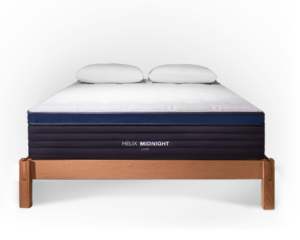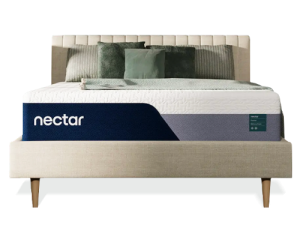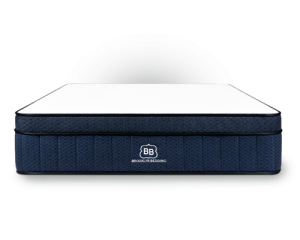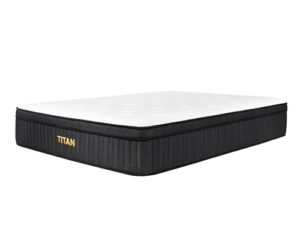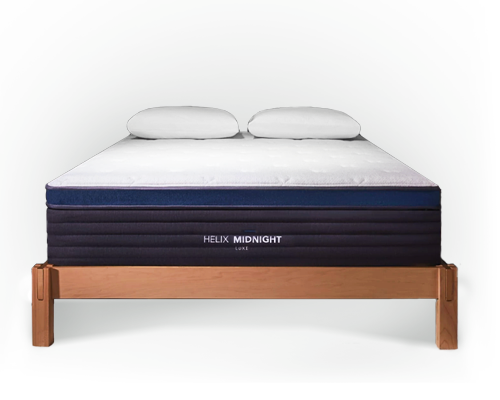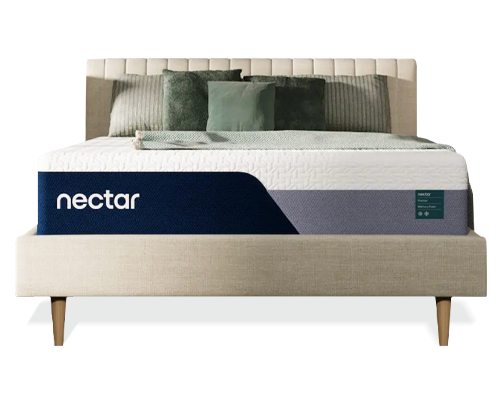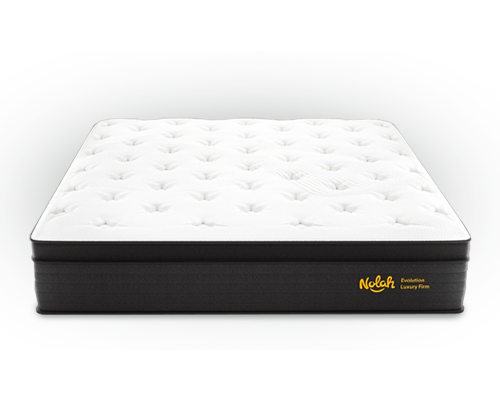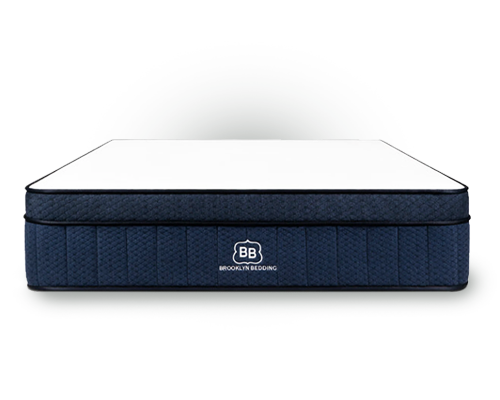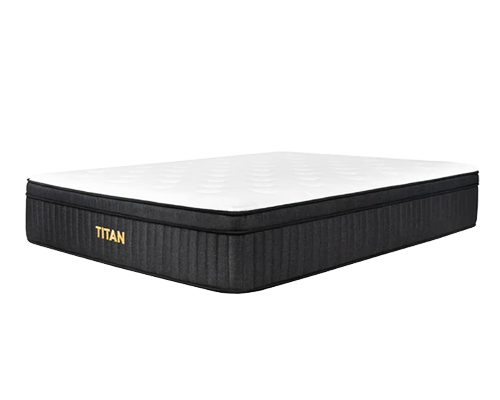- Price: $2,374 for a queen before discounts
- Material: Hybrid
- Brand’s firmness rating: Medium
- Mattress height: 13.5 inches
- Trial period: 100 nights
- Shipping: Free shipping, in-home delivery is available starting at $129
- Warranty: 15 years
- Offers financing: Yes
Best Mattresses for Insomnia in 2025: A Complete Guide
Key Takeaways
- Our pick for the best-rated mattress for insomnia is the Helix Midnight Luxe because it scored well across most relevant categories, including pressure relief, cooling, support, and bounce.
- A good mattress for insomnia offers great pressure relief, support, and cooling to promote better sleep quality.
- Queen-size mattresses in this review cost $1,249–$2,499 before discounts, with an average price of $2,057.
- Up to 50% of older adults report symptoms of insomnia.
- If you’re having symptoms of insomnia, talk to a health care professional for an evaluation.
Insomnia is a common sleep disorder that makes it hard to fall asleep or stay asleep. It can cause you to wake up earlier than you want and then have trouble falling back asleep, even if you’re still tired. While insomnia isn’t considered a normal part of aging, it does become more common as people get older, affecting up to 50% of older adults. This can cause reduced energy levels, irritability, and trouble concentrating.
While getting a new mattress may not cure the condition, choosing the best mattress for insomnia can potentially help by improving comfort, reducing pressure points, and supporting better spinal alignment, which may improve symptoms like tossing and turning, body aches, and restlessness.
“Many people with insomnia also have chronic pain, and the right mattress firmness can help reduce their nighttime discomfort, making it easier to rest,” explained Daniella Marchetti, PhD, DBSM, a licensed clinical psychologist and certified sleep specialist at Rise Science, a sleep technology company based in Chicago.
“The best mattress for a person with insomnia may differ from person to person, as everyone has a unique body shape, sleep position, and health conditions that may impact their comfort level. The mattress that fits you well will give you a floating sensation because it is offering proper support and pressure relief on the hips, shoulder, and lower back. A good mattress should align the spine and promote a regulated body temperature,” she adds.
In this review, we’ve rounded up five of the best mattresses for insomnia based on our testing experience and insights from sleep experts.
Best mattresses for insomnia in 2025
- Helix Midnight Luxe: Best Overall
- Nectar Premier: Best Affordable Mattress for Insomnia
- Nolah Evolution: Best Mattress for Back Sleepers with Insomnia
- Brooklyn Bedding Aurora Luxe Cooling: Best Cooling Mattress for Insomnia
- Titan Plus: Best Mattress for Higher-Weight Sleepers with Insomnia
Helix Midnight Luxe: Best Mattress for Insomnia Overall
How we scored the Helix Midnight Luxe after extensive testing:
Learn more about our testing and scoring methods.
Our expert take on the Helix Midnight Luxe mattress
The Helix Midnight Luxe is a hybridⓘ Hybrid mattresses combine the features of both innerspring and foam mattresses, with springs surrounded by a thick comfort layer of foam or latex. mattress with a soft, breathable plush pillow top, followed by three layers of pressure-relieving memory foam on top of individually wrapped coils. The coils under the shoulders are softer, while those along the hips and lower back are firmer to help maintain a neutral spineⓘ The spine’s natural curves at the neck, middle, and lower (lumbar) sections .
Our testers rate the Helix Midnight Luxe a 5.5 out of 10 on the firmness scale, making it a good option for most average-weight (130 to 250 pounds) and lighter-weight (less than 130 pounds) sleepers in different sleep positions. When lying on their backs, the mattress’s pillow top layer relieves pressure on their joints, while the responsive layers underneath provide support and keep their spine aligned. Testers say the mattress’s plush feel is also comfortable for side sleeping, rating it five out of five for back pressure relief, 4.5 out of five for side pressure relief, and four out of five for overall support.
The edge supportⓘ The bed’s stability along the edges is also impressive—testers say they can roll close to the edge of the mattress without feeling like they’re going to fall off. This can be helpful for people who want to use the mattress’s entire sleeping surface or who may struggle getting in and out of bed.
Our testers were surprised at how cool the Helix Midnight Luxe sleeps, giving it a five out of five for cooling. This is likely due to the breathable Tencelⓘ A brand of lyocell fiber made from wood pulp that’s known for being soft, breathable, and absorbent cover and copper-infusedⓘ Copper is a good conductor and can absorb and disperse body heat, helping to regulate body temperature. gel memory foamⓘ Memory foam with small gel pods designed for cooling in the third layer of the mattress. This could be a plus for people with insomnia since a cool environment can help you sleep more soundly.
The mattress has good bounce (four out of five), making it easier to move around during the night, but most bouncy mattresses aren’t the best at isolating motion. During testing, we felt a lot of movement from the other side of the bed, which may not be ideal for light sleepers who share the bed with a restless partner.
Because this mattress is softer, it may not offer enough support for higher-weight (more than 250 pounds) back and side sleepers.
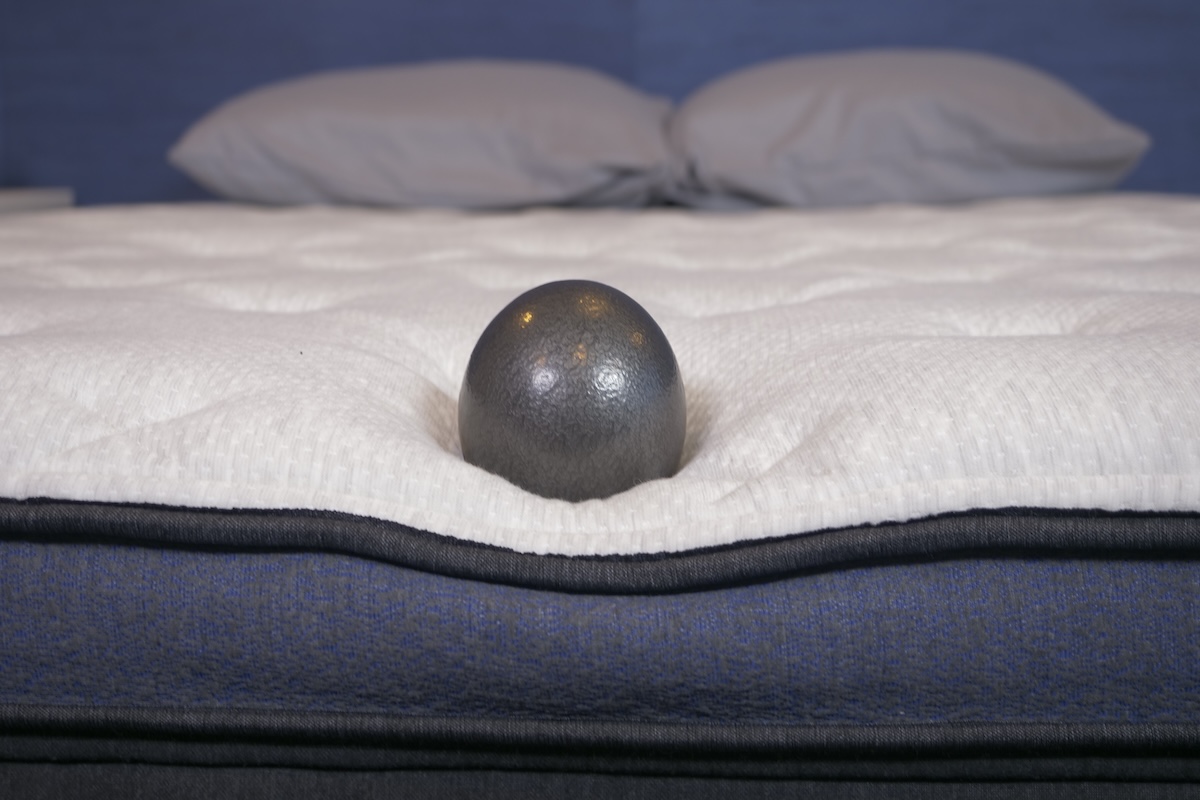
For those with lower back pain, Helix suggests upgrading the top layer of your mattress to the ErgoAlign Layer. This zoned layer features high-density foam beneath your midsection, offering added support and pressure relief.
Helix offers optional in-home setup starting at $129, the lowest price in our review. This makes it a good choice for people who prefer not to handle setup on their own.

Our tester on the Helix Midnight Luxe mattress:
“I love how the top layer feels really soft and plush, but there’s still plenty of support from the layers underneath.”
Who may love it
- Lighter-weight and average-weight back and side sleepers
- Stomach sleepers of all body types
- Hot sleepers
- People with lower back pain looking for extra support
- Those looking for a responsive mattress that makes it easier to move around in the bed
Who may want to avoid it
- Light sleepers who share the bed with a restless partner
- Higher-weight back and side sleepers who need a firmer sleep surface
For more information, see our Helix mattress review.
Nectar Premier: Best Affordable Mattress for Insomnia
Our testing scores
How we scored the Nectar Premier after extensive testing:
Learn more about our testing and scoring methods.
Our expert take on the Nectar Premier mattress
The Nectar Premier is an all-foam mattress that offers more cooling features and an extra inch of memory foam compared to the Nectar Classic. Despite these upgrades, it remains one of the most affordable mattresses in our review, with frequent promotions dropping the price below $1,000 for a queen. We also appreciate that Nectar exceeds industry standards by offering a lifetime warranty and a 365-night sleep trial.Our testers describe the Nectar Premier as having a medium feel, rating it 5.5 out of 10 for firmness. With a five out of five for back pressure relief, we feel it is one of the best mattresses for back pain. It’s also a good option for side sleepers, scoring a four out of five for side pressure relief. Testers say they feel more “in” than “on” the mattress and sink slightly into the top foam layers.

The mattress’s three inches of responsive support foam, located just beneath the memory foam, provides gentle support (three out of five) for lighter-weight and average-weight sleepers, though it may not be supportive enough for higher-weight back or stomach sleepers.
Testers say the Nectar Premier sleeps cool for a foam mattress, giving it a 4.5 out of five for cooling. This is likely due to the mattress’s breathable cover and gel-infused memory foam, which is designed to absorb and redistribute body heat.
As an all-foam mattress, the Nectar Premier lacks bounce, earning a two out of five from testers. While it isn’t as difficult to move around on as expected, it may not be ideal for those who need a more responsive surface and extra support. These sleepers might want to consider the Nectar Hybrid instead.

Our tester on the Nectar Premier mattress:
“This mattress is really comfortable for back and side sleeping. I don’t feel any pressure on my hips or shoulders, and my spine feels neutral.”
Who may love it
- Lighter- to average-weight sleepers
- People who want a soft mattress that offers good pressure relief
- Hot sleepers
- Sleepers who wake up easily from their partner’s movements
Who may want to avoid it
- Higher-weight back and stomach sleepers
- Sleepers who prefer a firmer, more responsive mattress to make changing positions easier
For more information, see our Nectar mattress review.
Nolah Evolution: Best Mattress for Back Sleepers with Insomnia
Our testing scores
How we scored the Nolah Evolution after extensive testing:
Learn more about our testing and scoring methods.
Our expert take on the Nolah Evolution mattress
The Nolah Evolution is a 15-inch thick mattress that offers excellent pressure relief and good support for back sleepers. It is available in four different firmness options, and testers rate the luxury firm model a seven out of 10 on the firmness scale.
During testing, the Nolah Evolution excelled in back pressure relief, earning a five out of five from our testers. When lying on our back, we see all blue on the pressure mapⓘ A mat with sensors that detects pressure buildup when someone lies across it , indicating no pressure buildup. Testers say the mattress’s top layer contours their lower back while the second layer offers support and keeps their spine neutral.
The Nolah Evolution stands out for its unique AirFoam layer beneath its 2-inch Euro topperⓘ A style of pillow top that provides an added layer of plush—the extra layer of padding is stitched beneath the mattress cover, so it’s flush with the edges of the mattress without adding extra height . This layer is perforatedⓘ Perforated foam or latex is designed by drilling holes through the material to increase the breathability and cooling capabilities of a mattress, as well as to increase the softness of the foam. near the head and foot of the bed, allowing the shoulders and legs to sink in comfortably, while firmer foam under the lower back adds extra support.
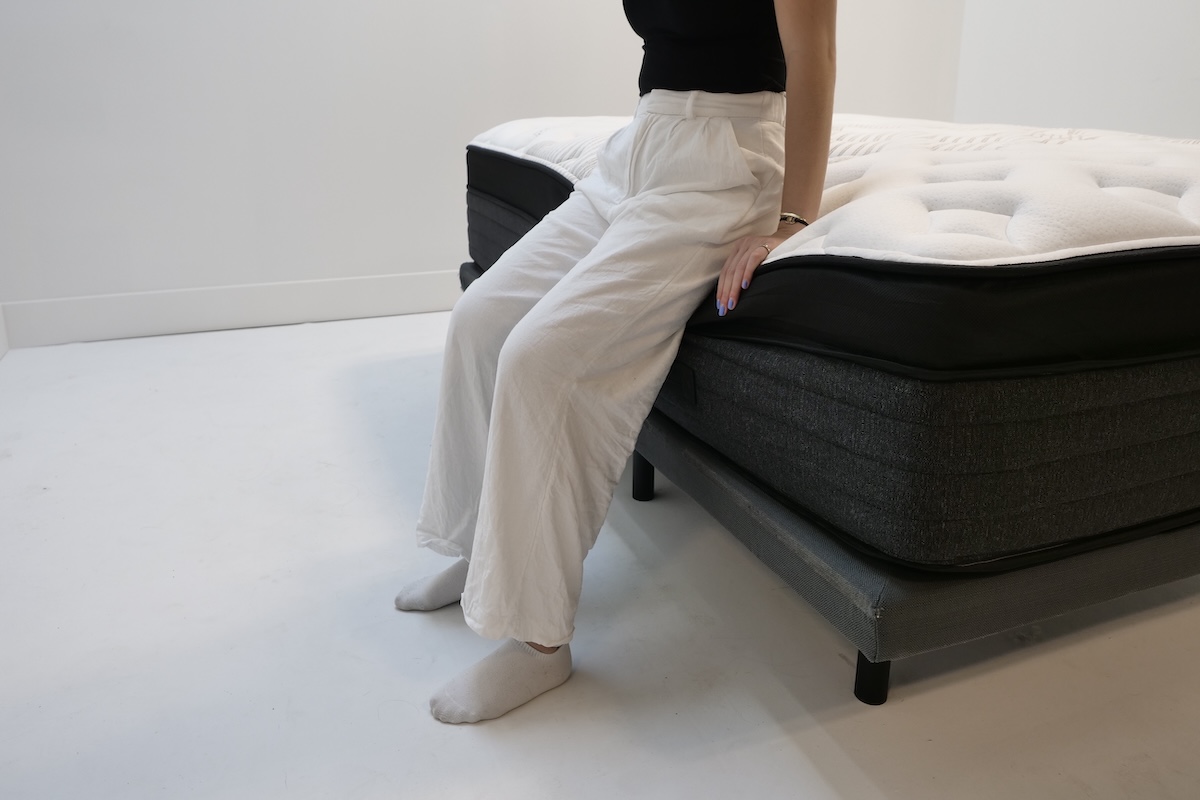
The mattress also has a thick layer of individually wrapped coils that are reinforced around the edges and divided into three regions for targeted support.
Although we selected the Nolah Evolution as best for back sleepers, testers say it provides enough support, responsivenessⓘ How much surface bounce a mattress has and how it responds to pressure or the sleeper’s movements, making it easier to move around and change sleeping positions , and pressure relief for all sleeping positions and body types. In fact, the mattress is also featured in our review of the best mattresses for side sleepers.
Despite having some bounce, the mattress isolates motion well, helping reduce movement from the other side of the bed.
The first four inches of the mattress are surrounded by an AirBreath border gusset designed to improve breathability, though our testers don’t note any above-average cooling effects.
Nolah offers a 120-night trial period, but if you’re sure you’ll love your mattress, you can opt out of the trial and save up to $100 off your purchase of a queen-size mattress. Note that this mattress is bulky, so we recommend paying the extra fee for white-glove delivery.

Our tester on the Nolah Evolution mattress:
“When I lie on my back, I sink just enough into the first layer but not too far. I feel a good mix of pressure relief and support.”
Who may love it
- Most sleepers of all body types and sleep positions, especially back sleepers
- Those who need extra lower back support
- Shoppers who prefer a higher mattress
- People who need an extra mobility boost to make moving around in bed easier
Who may want to avoid it
- People with high bed frames
- Those who want a cooling mattress
For more information, see our Nolah mattress review.
Brooklyn Bedding Aurora Luxe Cooling: Best Cooling Mattress for Insomnia
Our testing scores
How we scored the Brooklyn Bedding Aurora Luxe Cooling after extensive testing:
Learn more about our testing and scoring methods.
Our expert take on the Brooklyn Bedding Aurora Luxe Cooling mattress
The Brooklyn Bedding Aurora Luxe uses three cooling technologies throughout its layers to help regulate temperature and keep hot sleepers comfortable. The GlacioTex ⓘ Hypoallergenic fabric made from fibers with high thermal conductivity that allow heat to be quickly and effectively pulled away from your body cooling cover, which one tester describes as “icy” to the touch, uses cooling fibers to draw heat away from your body. Beneath the cover is 1.5 inches of Copperflex cooling foam, which contains copper—a natural antimicrobial agent that may help prevent bacteria and mold from building up. Copper has a high thermal conductivity, meaning it may help to draw heat away from the body, although more research is needed to confirm its cooling effects in mattresses.
Next, the 2-inch comfort layer is infused with cooling gel to relieve pressure and keep you cool while you sleep. The mattress also has a zoned supportⓘ Multiple firmness levels, or “zones,” built into a mattress so it can support different areas of the sleeper’s body in different ways t core of individually wrapped coils for breathability and support. When we tested the Aurora Luxe mattress, we immediately felt its cooling effect. After lying down for five minutes, the temperature gun showed a 5.9-degree increase, which indicates “very good” cooling properties.

The mattress comes in soft, medium, and firm options. We tested the medium model and found it to be quite firmer than expected, rating it 7.5 out of 10. But despite this firmer feel, our testers say the mattress offers excellent pressure relief and should be comfortable for most sleeping positions and body types. Testers say the mattress has great responsiveness, so you shouldn’t have trouble moving around.
For added contouring and pressure relief, you can select the Cloud pillow top. This upgrade costs around $400 for a queen-size mattress.
The Aurora Luxe arrives tightly compressed in a box at your doorstep. Since Brooklyn Bedding doesn’t offer white-glove delivery, be sure to have help moving and setting up the mattress.

Our tester on the Brooklyn Bedding Aurora Luxe Cooling mattress:
“The mattress cover feels much cooler to the touch than other mattresses I’ve tested.”
Who may love it
- Hot sleepers
- People of all body types and sleep positions
- Sleepers who need a mattress with maximum pressure relief
- Anyone who wants a responsive mattress that makes moving around in bed easier
Who may want to avoid it
- People who need help carrying a mattress into their home
- Those who prefer a soft, contouring sleep surface
For more information, check out our Brooklyn Bedding review.
Titan Plus: Best Mattress for Higher-Weight Sleepers with Insomnia
Our testing scores
How we scored the Titan Plus after extensive testing:
Learn more about our testing and scoring methods.
Our expert take on the Titan Plus mattress
The Titan Plus is a firm hybrid mattress made of high-density foam for pressure relief and a supportive base layer of individually encased steel coils. Its quilted cover is infused with gel foam to cradle the body and keep you cool while you sleep. Testers rate the mattress’s cooling performance at 4.5 out of five. Hot sleepers can upgrade to the GlacioTex cooling cover ($100–$250, depending on mattress size), which adds extra coolness to the surface.
Despite its firm feel (eight out of 10), testers say the Titan Plus does a great job relieving pressure. The pressure pad showed little to no pressure buildup when lying on their side or back. Testers noticed a bit of give when sitting on the edge but didn’t feel like they were going to roll off.

The mattress has a good bounce score, which should make it easy for combination sleepersⓘ People who sleep in more than one position throughout the night and people with mobility issues to move around and change positions.
Keep in mind that this is a firmer mattress designed for higher-weight sleepers. Lighter-weight sleepers and average-weight side sleepers may not sink enough into the foam layer to cushion their pressure pointsⓘ The parts of the sleeper’s body that are in direct contact with the mattress, such as the backside, shoulder, hips, and rib cage. .
If you sleep with a lighter-weight partner, the Titan Plus Luxe could be a good option. The Luxe, which has an extra layer of contouring memory foam, is designed for higher-weight sleepers who want a medium-firm feel or whose partners need more cushioning.
The Titan Plus mattress will arrive in a box, and white-glove delivery isn’t available. The company says the mattress can take up to 24 hours to fully decompress.

Our tester on the Titan Plus mattress:
“This mattress is ideal for higher-weight back, stomach, and combination sleepers. Couples may also appreciate how well the mattress absorbs movement.”
Who may love it
- Higher-weight sleepers in any position
- Stomach sleepers of all body types
- People who prefer a firm mattress
- Shoppers looking for an affordable mattress
Who may want to avoid it
- People who cannot find help to set up a mattress
- Lighter-weight and average-weight side sleepers
- Couples with a partner who weighs less than 130 pounds
For more information, see our Titan Plus review.
How we tested the best mattresses for insomnia
We’ve dedicated more than 1,000 hours to researching the mattress industry, consulting at least 10 health care professionals, and testing roughly 40 brands and 130 unique mattress models for quality and comfort. We’ve also interviewed 16 older adults who recently purchased a mattress and surveyed more than 3,200 recent mattress buyers to understand their experiences shopping for a new bed.
Each mattress undergoes a rigorous 36-page testing procedure to score its different characteristics, including firmness, support, and other aspects most shoppers consider. We chose the best mattresses for insomnia based on their scores in the most important criteria, including pressure relief, cooling, overall support, bounce, and motion isolation. To learn more about our testing and scoring methods, review our sleep methodology.

We test new mattresses each month to give you the most up-to-date information. Check back often for updates.
What is insomnia?
Insomnia is the most common sleep disorder in the United States. It is defined as trouble falling asleep, staying asleep, or both, even when there is enough time and opportunity to sleep.
Insomnia is typically classified as short-term (acute) or long-term (chronic). Short-term insomnia, often triggered by stress or acute pain, lasts for less than three months. Chronic insomnia is typically diagnosed when symptoms occur at least three times a week for more than three months and aren’t caused by another health issue.
Without treatment, insomnia can affect your ability to think, concentrate, and react. It can also increase the risk of high blood pressure, heart disease, diabetes, and cancer.
If you’re having difficulty sleeping, talk with a health care professional. They can take a look at your medical history and sleep history and perform a physical exam to identify possible causes of insomnia.
What causes insomnia?
Many things can trigger insomnia, including:
- Age: The risk of insomnia increases with age, with as much as 50% of older adults having insomnia.
- Family history and genetics: People who have family members with insomnia are more likely to have the condition. Your genes may also cause you to be a light or deep sleeper.
- Sex: Women are more likely than men to have insomnia.
- Sleep environment: Sleeping on an uncomfortable mattress or in a room that is noisy, too cold, too hot, or too bright can cause insomnia or make it worse.
- Stress: Worrying about things like finances, the health of a loved one, or relationships can cause insomnia.
- Health conditions: Chronic pain—whether caused by back pain or neck pain, arthritis, fibromyalgia, or another condition, can lead to sleep issues. Sleep apnea, restless legs syndrome, and frequent nighttime urination can also disrupt sleep.
- Lifestyle habits: Taking long naps during the day, not exercising enough, and using alcohol, nicotine, or caffeine before bed can increase your risk of sleep problems. Using a mobile device or watching television in bed can also trigger insomnia.
- Diet: Eating a heavy meal close to bedtime can make you feel uncomfortable and may cause heartburn. The foods you eat also matter. One study found that diets high in added sugars and refined grains (white rice, white bread, etc.) were linked to a higher risk of insomnia in postmenopausal women. On the other hand, eating more fiber, whole grains, and fresh fruits and vegetables was linked to a lower risk.
How to choose a mattress for insomnia
While a mattress may not cure insomnia, it can promote comfort and spinal alignment and regulate body temperature, which can lead to better sleep quality. When choosing the best type of mattress for insomnia, consider factors like firmness, support, pressure relief, and cooling capabilities.
Firmness
Firmness is subjective based on sleeping position, body type, and personal preference. Research shows that medium-firm mattresses work well for many people, though what we consider medium-firm may feel different for you.
From our experience, sleepers who weigh less than 130 pounds often find mattresses firmer, while those who weigh more than 250 pounds may find them softer. Back and stomach sleepers may prefer a slightly firmer mattress, while side sleepers usually benefit from a soft to medium-firm mattress that offers more pressure relief for the hips and shoulders.
Combination sleepers may find a medium-firm hybrid mattress with pocketed coils makes moving around in bed easier.
Support
A mattress with good support fills the gaps between the surface and your body, keeping your back comfortably aligned while you sleep. Some mattresses offer “zoned support,” which means they are firmer under the lower back and softer under the shoulders and hips to relieve pressure.
Pressure relief
Pressure relief refers to how well the mattress redistributes your body weight and eases pressure on areas like the hips and shoulders. A mattress without enough pressure relief could cause you to toss and turn throughout the night.
Cooling capabilities
Sleeping in a cool, dark room can help people with insomnia fall asleep and stay asleep. A recent study of older adults shows that the best temperature for sleep is between 68–77°F.
Hybrid and innerspring mattresses usually sleep cooler because their coils allow for better airflow. Some mattresses are made with gel-infused foam or breathable covers that wick away moisture. To ensure better sleep, look for mattresses with advanced cooling technologies or hybrid/innerspring designs.
Compare the best mattresses for insomnia as of 2025
| Price for queen | $2,374 | $2,286 | $2,499 | $1,865 | $1,249 |
| Mattress type | Hybrid | Foam | Hybrid | Hybrid | Hybrid |
| Mattress height | 13.5” | 13” | 15” | 13.25” | 11.25” |
| Cooling | 5/5 | 4.5/5 | 3/5 | 5/5 | 4.5/5 |
| Warranty | 15 years | Limited lifetime | Limited lifetime | 10 years | 10 years |
Bottom line
The best mattress for insomnia should support your body type, sleep position, and personal preferences while fitting within your budget. While the Helix Midnight Luxe is our top pick, we understand there’s no one-size-fits-all mattress. That’s why we included a range of options, including the Nectar Premier, Nolah Evolution, Brooklyn Bedding Aurora Luxe Cooling, and the Titan Plus, all of which excelled in different categories.
Lastly, all of the mattresses on our list come with at least a 100-night in-home trial period to test out the bed before deciding if it’s right for you.

Frequently asked questions
Yes. Some mattresses can help relieve pressure, keep you cool, and align your spine, which can help with insomnia. The key is finding a mattress that fits your sleeping style, body type, and personal preferences.
Avoid caffeine, stimulants, and alcohol before bed, and keep your sleep environment cool and dark. Sticking to a regular sleep schedule, relaxing before bed, and limiting screen time in the evening can also help improve sleep. Some people with insomnia use melatonin for sleep. Yet current research does not support the routine use of melatonin to treat chronic insomnia.
Research suggests that side sleeping may benefit people with insomnia caused by sleep apnea. The side-lying position may also help those with lower back pain, though it can still cause discomfort for certain people. Ultimately, the best sleep position varies and is one that allows you to fall asleep and stay asleep without interruptions.
Questions? Email us at reviewsteam@ncoa.org.
Sources
- Brewster G. S., et al. Insomnia In the Older Adult. Journal of Sleep Medicine Clinics. November 2017. Found on the internet at https://pmc.ncbi.nlm.nih.gov/articles/PMC5847293/
- National Heart, Blood, and Lung Institute. Insomnia Treatment. March 24, 2022. Found on the internet at https://www.nhlbi.nih.gov/health/insomnia/treatment
- Salah I., et al. Copper as an Antimicrobial Agent: Recent Advances. Journal of RSC Advances. May 19, 2021. Found on the internet at https://pubs.rsc.org/en/content/articlelanding/2021/ra/d1ra02149d
- American Psychiatric Association. What are Sleep Disorders? Found on the internet at https://www.psychiatry.org/patients-families/sleep-disorders/what-are-sleep-disorders
- Dopheide J. A. Insomnia Overview: Epidemiology, Pathophysiology, Diagnosis and Monitoring, and Nonpharmacologic Therapy. April 12, 2020. The American Journal of Managed Care. Found on the internet at https://www.ajmc.com/view/insomnia-overview-epidemiology-pathophysiology-diagnosis-and-monitoring-and-nonpharmacologic-therapy
- MedlinePlus. Insomnia. May 4, 2024. Found on the internet at https://medlineplus.gov/ency/article/000805.htm
- National Heart, Blood, and Lung Institute. What is Insomnia? March 24, 2022. Found on the internet at https://www.nhlbi.nih.gov/health/insomnia
- Gangwisch J.E., et al. High Glycemic Index and Glycemic Load Diets as Risk Factors for Insomnia: Analyses from the Women’s Health Initiative. The American Journal of Clinical Nutrition. February, 2020. Found on the internet at https://www.sciencedirect.com/science/article/pii/S0002916522010188
- Caggiari G., et al. What Type of Mattress Should Be Chosen to Avoid Back Pain and Improve Sleep Quality? Review of the Literature. Journal of Orthopaedics and Traumatology. Dec. 8, 2021. Found on the internet at https://jorthoptraumatol.springeropen.com/articles/10.1186/s10195-021-00616-5
- Baniassadi A., et al. Nighttime Ambient Temperature and Sleep in Community-Dwelling Older Adults. Science of the Total Environment. Nov. 15, 2023. Found on the internet at https://www.sciencedirect.com/science/article/abs/pii/S0048969723042468
- Choi K., et al. Efficacy of Melatonin for Chronic Insomnia: Systematic Reviews and Meta-Analyses. Sleep Medicine Reviews. December 2022. Found on the internet at https://www.sciencedirect.com/science/article/abs/pii/S1087079222001058
- Srijithesh P.R., et al. Positional Therapy for Obstructive Sleep Apnoea. Cochrane Database System Review. May 1, 2019. Found on the internet at https://www.cochranelibrary.com/cdsr/doi/10.1002/14651858.CD010990.pub2/full
- Ylinen J., et al. Preferences and Avoidance of Sleeping Positions Among Patients With Chronic Low Back Pain: A Cross-Sectional Study. Cureus. May 6, 2024. Found on the internet at https://www.cureus.com/articles/238621-preferences-and-avoidance-of-sleeping-positions-among-patients-with-chronic-low-back-pain-a-cross-sectional-study


